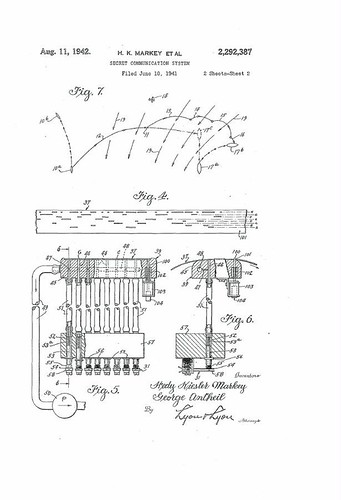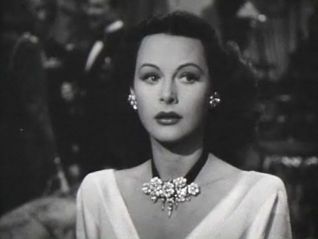Long-time readers of my blog know that I’m fascinated by Hedy Lamarr (originally – Hedwig Kiesler). In honor of Ada Lovelace Day (today!) I though I’d post a short run-down of the patent she and her collaborator, composer and pianist George Antheil, filed in 1942. The title on the patent was “Secret Communication System” and it outlines a way to radio-control a torpedo in a way that makes jamming very difficult. The scheme the movie star and the composer came up with is what later came to be know as frequency-hopping spread spectrum. Wikipedia says, succinctly:
Frequency-hopping spread spectrum (FHSS) is a method of transmitting radio signals by rapidly switching a carrier among many frequency channels, using a pseudorandom sequence known to both transmitter and receiver. *
If you’re camped on one frequency while trying to transmit control info to your torpedo, you’re a sitting duck – your signal can be swamped by a transmitter on your target. If you are hopping from frequency to frequency in a way that your adversary can’t predict, but the receiver in the torpedo can, you’re in much better shape.
The mechanism K and A used to sync the transmitter and the receiver was one that had been used to control musical instruments and would be used a couple decades later to load programs on computers – paper tape!
*
An interesting wrinkle – based on the tape above, I gotta believe that the frequency change interval is variable – perfectly understandable, given the one-to-one communication; it’s also a feature that would make an adversary’s job tougher.
Keeping the 2 tapes – one on the warship with the transmitter and one on the torpedo with the receiver – synchronized is essential.
Clearly the rolls have to start up at exactly the same time. In the invention each roll has an extra track and in that track is just one perforation inserted as a start marker. When the system was first armed (switched on), a little pin passed through this start perforation, restraining the roll from playing. The two pins were operated by an electromagnet, one at the ship end and one at the torpedo end. when the two electromagnets were switched on, that is when the device was armed, the pins appeared and were used to hold back the rolls. The electromagnets were connected together by two wires that ran from the ship’s transmitter equipment to the torpedo’s receiver. Once the torpedo was fired, the wires broke, breaking the circuit that operated the electromagnets, the two pins that held the roll withdrew and the rolls started playing at exactly the same instant… *
Additionally, they have to run at the same speed – not quite as big a trick as starting the run at exactly the same time.
It’s an excellent idea – perhaps a bit ahead of its time, but feasible (I think) given the tech of the day. It didn’t go anywhere though. Why? Two thoughts come to mind. The obvious explanation is that Kiesler and Antheil were outsiders. I can hear it now, “A movie star and a guy who writes ‘modern’ music have an idea for a torpedo remote control system? Haw, haw – tell me another.” Less obvious is an objection that may not have been apparent to Hedy. Hedwig Kiesler’s first marriage was to Friedrich Mandl, an Austrian arms dealer and manufacturer. The Germans were pioneers of electrically propelled torpedoes – Hedy may have heard discussion of them before her escape from Mandl and Austria in 1937. The problem was that the US used torpedoes powered by compressed air – no source of electricity to power the receiver.
In the overall scheme of things though, she and Antheil had a great idea – cheers, Hedy!



Did Antheil have something to do with the theremin or am I hallucinating?
I did a little nosing around and it looks like Antheil was in Europe at the right time, but I haven’t found any direct connection.